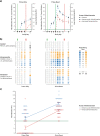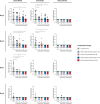ChAdOx1 nCoV-19 (AZD1222) vaccine candidate significantly reduces SARS-CoV-2 shedding in ferrets
- PMID: 33972565
- PMCID: PMC8110954
- DOI: 10.1038/s41541-021-00315-6
ChAdOx1 nCoV-19 (AZD1222) vaccine candidate significantly reduces SARS-CoV-2 shedding in ferrets
Abstract
Vaccines against SARS-CoV-2 are likely to be critical in the management of the ongoing pandemic. A number of candidates are in Phase III human clinical trials, including ChAdOx1 nCoV-19 (AZD1222), a replication-deficient chimpanzee adenovirus-vectored vaccine candidate. In preclinical trials, the efficacy of ChAdOx1 nCoV-19 against SARS-CoV-2 challenge was evaluated in a ferret model of infection. Groups of ferrets received either prime-only or prime-boost administration of ChAdOx1 nCoV-19 via the intramuscular or intranasal route. All ChAdOx1 nCoV-19 administration combinations resulted in significant reductions in viral loads in nasal-wash and oral swab samples. No vaccine-associated adverse events were observed associated with the ChAdOx1 nCoV-19 candidate, with the data from this study suggesting it could be an effective and safe vaccine against COVID-19. Our study also indicates the potential for intranasal administration as a way to further improve the efficacy of this leading vaccine candidate.
Conflict of interest statement
Oxford University has entered into a partnership with AstraZeneca for further development of ChAdOx1 nCoV-19. S.C.G. is a co-founder of Vaccitech (collaborators in the early development of this vaccine candidate) and named as an inventor on a patent covering the use of ChAdOx1-vectored vaccines and a patent application covering this SARS-CoV-2 vaccine (PCT/GB2012/000467). T.L. is named as an inventor on a patent application covering this SARS-CoV-2 vaccine and was a consultant to Vaccitech for an unrelated project, during the conduct of the study. The remaining authors declare no competing interests.
Figures





Similar articles
-
Tolerability and immunogenicity of an intranasally-administered adenovirus-vectored COVID-19 vaccine: An open-label partially-randomised ascending dose phase I trial.EBioMedicine. 2022 Nov;85:104298. doi: 10.1016/j.ebiom.2022.104298. Epub 2022 Oct 10. EBioMedicine. 2022. PMID: 36229342 Free PMC article. Clinical Trial.
-
Intranasal ChAdOx1 nCoV-19/AZD1222 vaccination reduces viral shedding after SARS-CoV-2 D614G challenge in preclinical models.Sci Transl Med. 2021 Aug 18;13(607):eabh0755. doi: 10.1126/scitranslmed.abh0755. Epub 2021 Jul 27. Sci Transl Med. 2021. PMID: 34315826 Free PMC article.
-
Safety and immunogenicity of the ChAdOx1 nCoV-19 (AZD1222) vaccine in children aged 6-17 years: a preliminary report of COV006, a phase 2 single-blind, randomised, controlled trial.Lancet. 2022 Jun 11;399(10342):2212-2225. doi: 10.1016/S0140-6736(22)00770-X. Lancet. 2022. PMID: 35691324 Free PMC article. Clinical Trial.
-
Acute Transverse Myelitis (ATM):Clinical Review of 43 Patients With COVID-19-Associated ATM and 3 Post-Vaccination ATM Serious Adverse Events With the ChAdOx1 nCoV-19 Vaccine (AZD1222).Front Immunol. 2021 Apr 26;12:653786. doi: 10.3389/fimmu.2021.653786. eCollection 2021. Front Immunol. 2021. PMID: 33981305 Free PMC article.
-
MOG encephalomyelitis after vaccination against severe acute respiratory syndrome coronavirus type 2 (SARS-CoV-2): case report and comprehensive review of the literature.J Neurol. 2022 Oct;269(10):5198-5212. doi: 10.1007/s00415-022-11194-9. Epub 2022 Jun 23. J Neurol. 2022. PMID: 35737110 Free PMC article. Review.
Cited by
-
Recent advances in respiratory immunization: A focus on COVID-19 vaccines.J Control Release. 2023 Mar;355:655-674. doi: 10.1016/j.jconrel.2023.02.011. Epub 2023 Feb 17. J Control Release. 2023. PMID: 36787821 Free PMC article. Review.
-
Key Considerations for the Development of Safe and Effective SARS-CoV-2 Subunit Vaccine: A Peptide-Based Vaccine Alternative.Adv Sci (Weinh). 2021 Aug;8(16):e2100985. doi: 10.1002/advs.202100985. Epub 2021 Jun 27. Adv Sci (Weinh). 2021. PMID: 34176237 Free PMC article. Review.
-
SARS-CoV and SARS-CoV-2 display limited neuronal infection and lack the ability to transmit within synaptically connected axons in stem cell-derived human neurons.J Neurovirol. 2024 Feb;30(1):39-51. doi: 10.1007/s13365-023-01187-3. Epub 2024 Jan 3. J Neurovirol. 2024. PMID: 38172412 Free PMC article.
-
Highly Thermotolerant SARS-CoV-2 Vaccine Elicits Neutralising Antibodies against Delta and Omicron in Mice.Viruses. 2022 Apr 13;14(4):800. doi: 10.3390/v14040800. Viruses. 2022. PMID: 35458530 Free PMC article.
-
Intranasal COVID-19 vaccines: From bench to bed.EBioMedicine. 2022 Feb;76:103841. doi: 10.1016/j.ebiom.2022.103841. Epub 2022 Jan 24. EBioMedicine. 2022. PMID: 35085851 Free PMC article. Review.
References
-
- CSSE. COVID-19 Dashboard by the Center for Systems Science and Engineering (CSSE) at Johns Hopkins University.https://coronavirus.jhu.edu/map.html (2020).
LinkOut - more resources
Full Text Sources
Other Literature Sources
Miscellaneous

